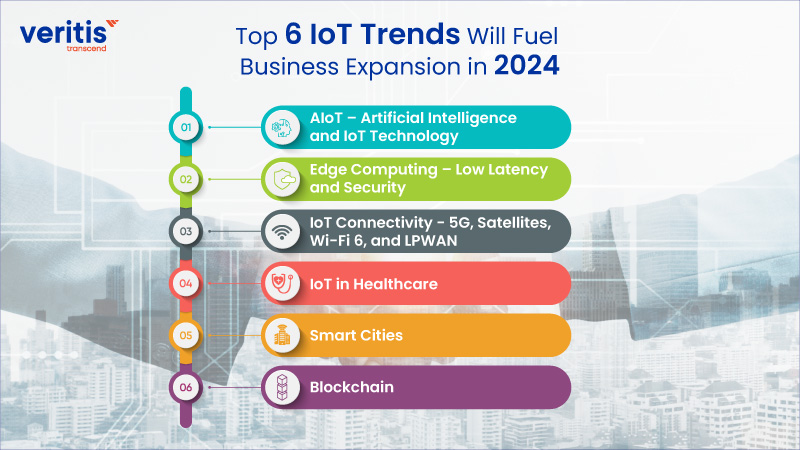
It’s arduous to remove the “Internet of Things” from a list of cutting-edge and paradigm-shifting technologies in a world dominated by ever-evolving connection technology and artificial intelligence. However, IoT trends may be among the most potent technologies currently in use, as it is essential to developing multiple other technologies, such as machine learning.
Firms must keep track of changes as the market landscape changes over the following years. Companies that think imaginatively about developing technology have some of the best IoT for business outcomes. Keeping an eye on these developments is necessary for developing concepts for novel applications and combinations of these technologies. Let’s discuss how IoT business technology will develop and the Internet of Things trends that will influence global markets in 2024.
IoT is a network of real-world items equipped with sensors, software, and other technologies to exchange and transmit data with other systems and gadgets online. These devices cover the gamut of everyday domestic items to modern industrial tools.
The number of IoT devices installed globally is currently over 7 billion. It is anticipated that that figure will surpass 30 billion by 2025. This technology has an even more significant positive impact on the economy. A Finance Online report states that at least 25 billion IoT devices will be used within the next seven years. 75% of all devices are anticipated to be IoT-based by 2030.
As of 2024, the global economy is marked by a projected estimated Global GDP of USD 88.3 trillion, according to the International Monetary Fund (IMF). The unemployment rate globally averages around 5.3%, as reported by the International Labour Organization (ILO). In the technology sector, the Internet of Things (IoT) has seen significant growth with over 14 billion connected devices worldwide, according to Exploding Topics.
According to Global Data, Cellular IoT connections have reached 3.5 billion, as noted by Antino Labs, contributing to a market value in the IoT sector approaching USD 1.1 trillion. However, it’s worth mentioning that significant stock market indices are experiencing volatile fluctuations during this period.
A Snippet of the IoT World
How many people do you witness wearing smartwatches over analog or digital ones? Here is a simple example of IoT devices’ prevalence in today’s generation. Today, a smart watch is worn on almost every wrist and constantly moves host data from one device to another via an internet connection. Yet, for the average person, the volume of data gathered, tracked, and sent online today through these IoT gadgets is unfathomable.
High internet connectivity, the low cost of sensors for devices, and a reliance on smartphones to an extreme extent are the fundamental causes of the IoT’s explosive rise. However, the most marketable aspect of this technology is the convenience it provides to people. Finishing predetermined activities takes little human contact or command transmission, which is advantageous for multitasking. As a result, IoT businesses are thriving in developed countries such as the UK and the US.
It makes you ask what more life-changing IoT trends are being pushed by this technology now that these smart devices have become ubiquitous in our daily lives. What changes are being made in the sector to make room for this technology in the workplace?
So, let’s go through the six most recent business IoT trends that will soon take off, all owing to the IoT advancements made possible by IoT applications and AI.
Useful link: Anomaly Detection with MI & AI : An Introduction
The Future of IoT Solutions
The IoT trends serve as compelling evidence that IoT for business and consumer-oriented IoT solutions are becoming increasingly powerful and efficient, effectively addressing diverse tasks. Foreseeing the continuous evolution of IoT business technology, it is plausible to anticipate the emergence of new products beyond our imagination. This progress will be propelled by the broader implementation of advanced IoT connectivity technologies, tools, and models such as edge computing and 5G connectivity.
Various industries and sectors are actively leveraging IoT business systems and applications today, including healthcare, manufacturing, agriculture, transportation and logistics, warehouse management, and more. With enhanced functionality, the future holds promise for a surge in IoT use cases, potentially leading to the inclusion of additional industries among active IoT adopters.
Top 6 IoT Trends Will Fuel Business Expansion in 2024

Trend #1: AIoT – Artificial Intelligence and IoT Technology
Artificial intelligence and the Internet of Things applications are two IoT connectivity technologies that work well together. Unsurprisingly, when they work together, they produce wiser results that businesses may investigate.
As was already noted, IoT devices produce a significant amount of data daily, and AI is a data-driven technology that thrives on these enormous data sets. AI software can develop its machine learning capabilities and create more innovative algorithms thanks to the live data transferred from IoT devices.
Trend #2: Edge Computing – Low Latency and Security
Edge computing underpins real-time applications. Edge networks handle information closer to the user and reduce network strain for all users by processing information locally rather than centrally.
Edge computing can improve data processing security and reduce the latency of IoT business technologies. There are fewer opportunities for hackers to intercept IoT data analytics if it may be processed on an edge device rather than sent to a central server. All that is required is to exchange information with the edge device and then give the user their information back. Here, memory-based storage of IoT data analytics is not necessary.
Any circumstance requiring quick choices benefits from edge computing. This is especially true in situations involving safety and security. IoT edge computing can protect humans from harm by automatically preventing machines from working when someone is in a restricted area at a factory. Likewise, autonomous vehicles’ ability to make crucial real-time decisions can spell the difference between life and death on the road. For instance, some of the latest smartphones can detect car crashes that you are involved in and contacts emergency services. Decades ago, this instance would have sounded like it was straight from a Sci-Fi movie, but now, thanks to IoT, it is a reality.
Trend #3: IoT Connectivity – 5G, Satellites, Wi-Fi 6, and LPWAN
Wireless data rates have been the critical obstacle IoT networks have overcome in recent years. IoT strategy components, including sensors, edge computing, wearables, smart homes, and more, will advance as these technologies do. In addition, IoT solutions are now more practical because of recent infrastructure development for newer connectivity kinds. They include satellites, Wi-Fi 6, LPWAN, and 5G as connectivity IoT technologies.
A) 5G
Many Internet of Things solutions require the installation of connectivity infrastructure before various edge devices, sensors, or other devices can keep up and running. Mobile networks like LTE may be a viable alternative for some circumstances, such as outdoor settings. But bandwidth is a restriction with 4G LTE. However, the IoT data analytics processing required for IoT networks may be supported considerably more effectively by 5G networks, which are much quicker.
Whether it is a mobile network like 4G LTE or IoT cloud services, a solid connectivity infrastructure is required for IoT to operate without a hitch in a given setting.
B) Satellites
Satellites can occasionally provide electricity for IoT networks that are spread over different geographies. For instance, Traksat’s satellite-powered Internet of Things (IoT) devices let humanitarian workers report emergencies and promptly call for help, thanks to Globalstar satellites. Likewise, GPS data is promptly recorded and forwarded to a base for making rescue plans. A critical feature that is coming up in smartphones is that now the devices can initiate contact with LEO satellites should one lose contact with the cellular providers.
C) Wi-Fi 6
The bandwidth capacity of IoT technology is substantially increased for indoor environments by Wi-Fi running in the 6 GHz bands. A network of devices will be more reliable when it can communicate more quickly. Additionally, Wi-Fi 6 can be utilized in homes, which can be very advantageous for IoT strategy networks for smart homes.
D) LPWAN
A developing technology that works well for connecting devices that need little bandwidth and a bit rate over a broader region is low-power wide-area network connectivity. It’s a suitable option for IoT devices because it enables machine-to-machine communication. In addition, LPWANs are more economical since they use less energy. Therefore, LPWAN technology is a wise choice if you need to use many devices across a big area.
Useful link: Impact of Digital Transformation in Healthcare Industry
Trend #4: IoT in Healthcare
IoT adoption and other significant digitalization initiatives are occuring in the healthcare IoT industry trends. However, due to its ability to improve diagnosis and allow for more individualized treatment, the Internet of Things in business has the power to alter the sector altogether. Therefore, the Internet of Medical Things (IoMT), a subset of the more significant digital health notion, has emerged as a separate entity.
Hospitals all across the world have started to employ IoT in the following ways:
- Smart diagnostic tools
- Medical accessories
- Gathering and analysis of patient data
- Robotic surgeries
- Monitoring systems to track patients and regulate storage conditions in labs
Trend #5: Smart Cities
IoT technology has a wide range of uses for creating networks for smart cities. One of the most critical challenges is traffic monitoring. It is possible to control better intersections for improved traffic optimization by monitoring traffic using sensors across the city. In addition, monitoring water levels can help alert residents to be current and potential floods and assist in detecting such events. Also, this information can direct further steps to stop future flooding.
There are several potential uses for smart streetlights. They serve as platforms for sensors to track traffic, monitor weather, host free Wi-Fi, and carry out surveillance. Moreover, these streetlights can be edge devices for digital street sign control. Even the light pole itself may be mounted with the streetlights.
Trend #6: Blockchain
The rising use of blockchain technology is one of the most recent IoT innovation trends. Blockchain is a beautiful fit for IoT applications as they are likewise dispersed in nature. Moreover, it may help ensure data security in IoT devices, facilitate robust interaction between diverse network nodes, and ensure safe record-keeping.
Blockchain, a decentralized and distributed ledger technology, is beginning to dominate nearly all applications in banking, agriculture, finance, transportation, and other industries. These developments are conceivable when this technology is paired with another, such as the Internet of Things applications.
Conclusion
The future of IoT trends will undoubtedly be crucial in the coming years as the Internet of Things solutions continue to expand globally. The advancement of global connection and IoT will be significantly aided by crucial technologies such as 5G, blockchain, AI, IoT cloud platform computing, and others.
Veritis, the Stevie Award winner, is one of the top providers in IoT application development, as we can assist you in integrating your services and products with IoT. You can contact us so we can guide you in magnifying what you can radiate.
Got Questions? Schedule A Call
Also Read:
- Top 5 Tech Trends CIOs Must Focus on for 2023
- Guide to Digital Transformation Technologies and Their Business Impact
- What Technologies Enable Digital Transformation?
- How Does AI Work and How Can it Help Leaders Make Better Decisions
- How AI Adoption Will Transform Your Business
- AI-Powered, ML-Driven – The New DevOps Trend!